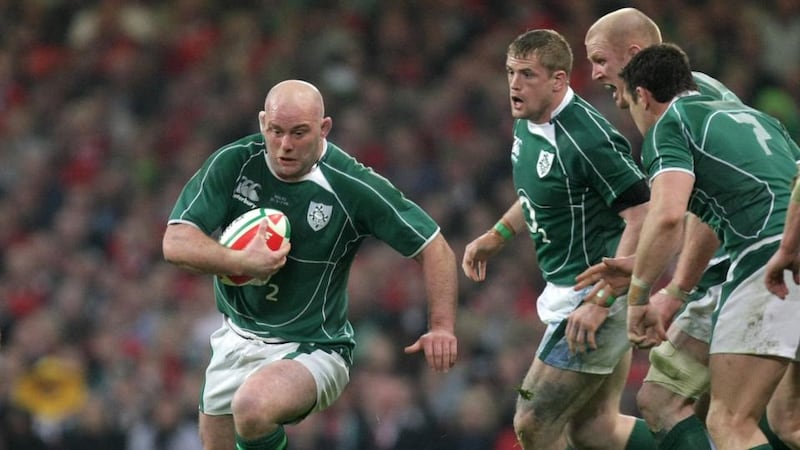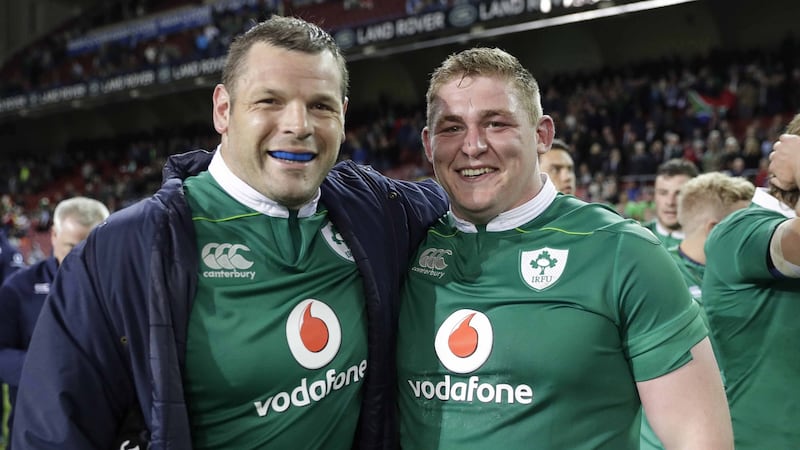Traditionally, Ireland’s prop cupboard has been as barren as the supermarket bread shelves in recent days.
For 16 seasons of the Six Nations in succession, from 2000 to 2016, there were only John Hayes and Mike Ross at tighthead. They were the only two Irish players to wear the number three jersey for an astonishing 79 games in a row, and, for much of that time, heaven help the Irish team if either of them so much as sneezed.
Fortunately, among their many strengths, they were durable, too. Hayes made his debut, along with Simon Easterby, Peter Stringer, Ronan O'Gara and Shane Horgan, in that restorative 44-22 win over Scotland at Lansdowne Road in February 2000 – the first of 54 consecutive Six Nations starts, until his final game in the tournament against Scotland in 2010 at Croke Park.
More often than not, the Bull completed 80 minutes as well, and only twice did he fail to play at least an hour. He never missed a minute in several campaigns and, for example, he played all bar the last three minutes in Cardiff in Ireland’s 2009 Grand Slam.
It was similar when the baton was passed on to Ross for his Six Nations debut in the opening win of 2011 against Italy. In his first three campaigns, he completed 80 minutes seven times, and only once was forced to come off before the hour.

That happened against England in the 2012 finale. Ross had played all bar the last two minutes against Scotland of the previous four games, but was forced off in the 37th minute with a knee injury at Twickenham. This was back in the days when teams were only permitted one prop on the bench and so Tom Court, essentially a loosehead, was obliged to play at tighthead.
All those fears of the previous dozen years were realised. The Irish scrum was also suffering some grief, Owen Farrell kicking two scrum penalties to ease them into a 9-3 lead before Ross departed, but thereafter it was carnage.
Both England’s penalty try and Ben Youngs’s try off a quick tap emanated from their scrum supremacy as, all told, did 27 of their points in a 30-9 win.
Specialist
The load on Ross was eased by the advent of two specialist props being permitted from the 2012-2013 season onwards, and especially by the emergence of Marty Moore, who saw out the last quarters in all 10matches for Ireland's 2014 and 2015 Six Nations titles.
But an injury to Ross at the start of the 2016 Six Nations was compounded by Moore also being sidelined, and so Nathan White made his Six Nations debut at home to Wales, with Tadhg Furlong, then 23 and with only three caps off the bench, also making his Championship debut.
The conveyor belt has gradually, but fairly quickly, begun chugging Test props like never before
The Irish scrum struggled in that 16-all draw, and again in the ensuing 10-9 defeat to France a week later, when the tries conceded to Taulupe Faletau (against Wales) and Maxime Médard resulted from intense scrum pressure. As with Hayes, Ireland were still dependent on the then 36-year-old Ross, and he returned for the games against England, Italy and Scotland, before Furlong assumed the mantle.
It’s worth recalling too that, in 2012, the situation regarding Ireland’s stock of props was in a fairly critical situation, which went down to provincial level. For three seasons, from 2011 to 2014, John Afoa and BJ Botha were the starting tightheads at Ulster and Munster, with Leinster also compelled to sign CJ van der Linde and Stan Wright.
So what changed?
The turnaround can probably be attributed to the appointments, in turn, of Colin McEntee as the IRFU's high performance manager in 2012, of David Nucifora as IRFU performance director in April 2014, and Greg Feek as national scrum coach. The latter's role also embraced aiding the National Scrum Development Programme.
They oversaw think tanks with scrum coaches at all the representative teams, and, to telling effect and in tandem with talent identification, Nucifora and the IRFU also restricted the number of overseas props. The investment in good coaching throughout the provinces, at senior and academy level, also bore fruit, with Jerry Flannery at Munster, John Fogarty at Leinster, Dan McFarland and latterly Jimmy Duffy at Connacht, and Ambrose Conboy with the Irish Under-20s.

The conveyor belt has gradually, but fairly quickly, begun chugging Test props like never before. As well as two Lions vying for the loosehead positions at Leinster and Ireland, Cian Healy and Jack McGrath, David Kilcoyne has been playing the rugby of his life and James Cronin has been knocking on the door.
After early identification and steady investment – witness a gap of almost a year between his first Irish cap and his first Test start – Furlong has also emerged as a world-class Lions tighthead. Meantime, such is the array of looseheads that Andrew Porter has been converted into a tighthead so smoothly he was able to manfully fill in for Furlong against Italy, for 77 minutes, and Wales.
Porter, like Healy, McGrath, Kilcoyne and Furlong, is also a modern-day Test prop, who can supplement their effectiveness in the tight with a high work-rate in defence and attack, such is their mobility, strong carrying games and good hands.
With more game time at Munster, John Ryan has also emerged as a genuine tighthead option as well as Stephen Archer and Finlay Bealham, and next season Moore will be back in the mix on joining Ulster.
That is 10 props to have been capped at Test level in recent times, all plying their trade in the provincial system. The cupboard has never been so well stocked.
gthornley@irishtimes.com
















